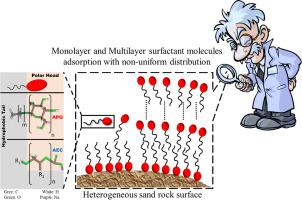Chemical Engineering Journal ( IF 15.1 ) Pub Date : 2020-09-23 , DOI: 10.1016/j.cej.2020.127081 Ahmed F. Belhaj , Khaled A. Elraies , Mohamad S. Alnarabiji , Firas A. Abdul Kareem , Juhairi A. Shuhli , Syed M. Mahmood , Hadi Belhaj

|
Throughout the application of enhanced oil recovery (EOR), surfactant adsorption is considered the leading constraint on both the successful implementation and economic viability of the process. In this study, a comprehensive investigation on the adsorption behaviour of nonionic and anionic individual surfactants; namely, alkyl polyglucoside (APG) and alkyl ether carboxylate (AEC) was performed using static adsorption experiments, isotherm modelling using (Langmuir, Freundlich, Sips, and Temkin models), adsorption simulation using a state-of-the-art method, binary mixture prediction using the modified extended Langmuir (MEL) model, and artificial neural network (ANN) prediction. Static adsorption experiments revealed higher adsorption capacity of APG as compared to AEC, with sips being the most fitted model with R2 (0.9915 and 0.9926, for APG and AEC respectively). It was indicated that both monolayer and multilayer adsorption took place in a heterogeneous adsorption system with non-uniform surfactant molecules distribution, which was in remarkable agreement with the simulation results. The (APG/AEC) binary mixture prediction depicted contradictory results to the experimental individual behaviour, showing that AEC had more affinity to adsorb in competition with APG for the adsorption sites on the rock surface. The adopted ANN model showed good agreement with the experimental data and the simulated adsorption values for APG and AEC showed a decreasing trend as temperature increases. Simulating the impact of binary surfactant adsorption can provide a tremendous advantage of demonstrating the binary system behaviour with less experimental data. The utilization of ANN for such prediction procedure can minimize the experimental time, operating cost and give feasible predictions compared to other computational methods. The integrated workflow followed in this study is quite innovative as it has not been employed before for surfactant adsorption studies.
中文翻译:

用于提高采收率的表面活性剂吸附的实验研究,二元建模和人工神经网络预测
在提高采油率(EOR)的整个应用中,表面活性剂的吸附被认为是该工艺成功实施和经济可行性的主要制约因素。在这项研究中,对非离子和阴离子表面活性剂的吸附行为进行了全面研究。即,使用静态吸附实验进行烷基聚葡萄糖苷(APG)和烷基醚羧酸盐(AEC)的研究,使用(Langmuir,Freundlich,Sips和Temkin模型)建立等温线模型,使用最新方法进行吸附模拟,二元使用改进的扩展Langmuir(MEL)模型和人工神经网络(ANN)预测混合物预测。静态吸附实验表明,与AEC相比,APG的吸附能力更高,sips是最适合R 2的模型(对于APG和AEC分别为0.9915和0.9926)。结果表明,单层和多层吸附均发生在表面活性剂分子分布不均匀的非均相吸附体系中,与模拟结果吻合良好。(APG / AEC)二元混合物预测描述了与实验个体行为相矛盾的结果,表明AEC在与APG竞争中吸附岩石表面上的吸附位点时具有更高的亲和力。所采用的人工神经网络模型与实验数据吻合良好,APG和AEC的模拟吸附值随温度升高呈下降趋势。模拟二元表面活性剂吸附的影响可提供以较少的实验数据证明二元体系行为的巨大优势。与其他计算方法相比,将ANN用于此类预测程序可以最大程度地缩短实验时间,降低运营成本并提供可行的预测。这项研究中遵循的集成工作流程具有相当大的创新性,因为之前尚未用于表面活性剂吸附研究。



























 京公网安备 11010802027423号
京公网安备 11010802027423号